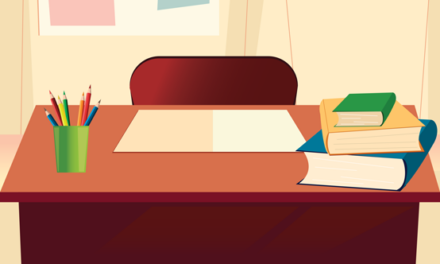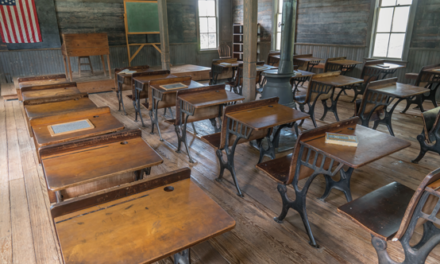A curious 5th grader becomes a teacher who wants her students to ask disruptive questions.
My 5th-grade teacher thought I was trouble. She glared at me sideways through her thick acrylic glasses. Her nude nylons squeaked as she passed by my desk, ignoring, as always, my incessantly raised hand. She called on Alan or Kay instead. When I persisted in waggling my hand in the air or simply blurting out queries, she moved my desk to the back of the classroom, so at least she didn’t have to see my flailing arm. When that proved no more effective in quashing my queries, she moved me back to the front, hoping, I suppose, to keep me directly under her thumb. When none of these tactics worked, she reported me to the authorities.
When my name crackled over the intercom, I went to meet with a social worker in the back of the school library. I liked her immediately. We talked about school and Judy Blume and Family Ties and my Odyssey of the Mind team. She asked me lots of questions, and I luxuriated in the chance to speak freely. I reciprocated with questions of my own: Where was she from? Did she have kids? What did she do when they were naughty? How did she feel about Ronald Reagan? Did she listen to Madonna? And, more to the matter at hand, didn’t she think my teacher was unreasonable? I sensed that she liked my questions, answering them fully while looking me squarely in the face. She did not listen to Madonna, but she did like Ronald Reagan.
In the end, though, my genial social worker answered to the school and, by extension, to my exasperated teacher. So together we drafted a behavior modification plan. She explained that it was a contract, and if I satisfied my end of the agreement, I’d be rewarded by getting to spend an hour each week helping in the kindergarten room. That didn’t seem like much of a reward, but it was better than being in my own classroom, so I assented. In the 30 years since, I’ve wondered if that social worker sensed that the girl who loved to ask questions would find the helm of the classroom a more hospitable place than behind a student’s desk.
The terms of the contract were simple: I would be allowed to ask five questions over the course of any one school day. If I managed to restrict myself to just 20 questions in a week, I’d get to sound out cat and pig with the kindergartners down the hall, which turned out to be a fine way to start my teaching career. But should I suffer an unfortunate bout of curiosity, I’d find myself in the principal’s office, reflecting on my inquisitive misdeeds. The irony was not lost on me: If I refrained from asking too many questions of my teacher, then I would get to ask as many questions as I liked while helping teach the kindergartners.
At that time, in 1986, my own harried teacher had two dozen kids in her Northern Michigan classroom, a 5th- and 6th-grade “split.” Thirty years later, I can imagine how she regarded that small, blonde girl who wanted — no, needed — to know why Lansing was the state capital; how and why, exactly, the region’s Chippewa Indians were vanquished; why all fractions needed to be reduced to their lowest terms; what really caused the Challenger explosion, or why the boys were allowed to gang up and violently pelt the girls during dodgeball. In my youthful taxonomy of questions, I’d hopscotch between the factual and the philosophical, from the instrumental to the open-ended; all felt urgent to me and, I suspect, disruptive to her.
Questioning or compliant
American psychologist Robert Sternberg has argued that children “are natural question-askers.” Eager to comprehend their environments, kids relentlessly query the players who make up their daily lives, trying to color in the outlines and give shape to the world. And when their questions are met with enthusiasm and generosity, children deepen and complicate their questions still further. My teacher could not have known Sternberg’s work on questions because, in 1986, he had not yet published it. I imagine she thought that by restricting my questions, she’d make me more fit to be a girl in the world, more tractable, more compliant, more eager to please. I suspect she saw me as taking up too much space in the room or as being, quite simply, annoying.
As is almost always the case, when you tell an exuberant child no, you invite her resistance, her rebellion, her irrepressible desire to do just the opposite.
Had it worked as designed, my behavior contract would have taught me to accept my teacher’s prerogative as absolute. Accordingly, I would have restricted my curiosity to questions that our family’s burgundy Encyclopedia Britannica volumes could answer for me in the two hours after dinner and before bedtime. But as is almost always the case, when you tell an exuberant child no, you invite her resistance, her rebellion, her irrepressible desire to do just the opposite. My behavior contract, aimed at eradicating my impulse to ask, left me with a new understanding about questions. They must be potent if they could so irritate or enrage an adult. If she didn’t want me to use them, I reasoned, it must mean that they were a 10 year old’s superpower, an awesome way to disrupt an orderly public school classroom, make a teacher uneasy, and resist the forces of compliance and conformity.
Although I didn’t know it then, my social worker was the clever one. By putting me at the front of the kindergarten room, she placed my questions in a more congenial home, where they were transformed from an oppositional weapon to a pedagogical tool. Like most mischievous 10 year olds, I still occasionally rejoiced in my power to knock my rigid teacher off balance, but more often, I found greater pleasure in posing questions that made kindergarten hands dash into the air.
When my teacher begrudgingly gave me permission to ask one of my five measly questions, I’d concentrate and condense the chain of 12 interconnected curiosities spinning through my mind down to one meaty, layered query. My “may I ask you a question?” soon became my shorthand for “may I have some space to wonder about these things that fascinate me?” If my teacher was feeling unusually generous, the classroom opened up, both to me and to the others who joined in the conversation. If she curtly suggested that I reserve my allowance for our science activity about electricity or our reading group’s debate, I withdrew, sullenly sensing that I didn’t yet fit into this place.
Permission to ask freely
This experience left me with a lingering verbal tic that I’ve never been able to eradicate completely, the habit of asking permission before posing a question. I took that tic with me through junior high and high school, and even to my small liberal arts college in Vermont. During my first semester there, my remarkably kind and patient Judaism professor politely asked me why I was always asking him if I could ask a question. By 1995, I had stopped dwelling on my experience in 5th grade, and I certainly didn’t connect my verbal tic to that behavior contract. I wasn’t exactly sure why I always asked his permission, I told him, but I’d try to work on it. He laughed for a moment and then turned serious: “Your questions are keen, important. Keep asking them. Ask even more. But stop asking for permission from me or anyone else.”
Suddenly, in that moment, I felt free, as though my professor had finally released me from the obligation to limit my questions. And while he didn’t quite cure me of the habit of asking before asking, he did make me think about permission in a new way. Where it was once the anxious tic of a 10 year old with a tiny budget for her curiosity, it became an acknowledgment of the dialogic nature of the classroom. Now, when I sought my generous professor’s permission to ask questions, I was really asking for him to think alongside me, to step with me into that oldest pedagogy, into the Socratic dialogue, the outcome of which neither of us knew.
This, in turn, is what we did for the next four years of my college experience: I asked him questions (to which he occasionally said that he had no idea what the answer was); he asked me questions (to which I occasionally said that I had no idea what the answer was), we reasoned together through ancient texts and researched contemporary responses to those texts. In the process, I began to see myself as someone with a keen voice in the classroom, someone with agency and ability to determine how I might use this question superpower to understand my world more fully.
Each of my questions drove me to another, better question, and that one to an even more refined question.
My professor helped me recognize a taxonomy of questions that made the rest of college, certainly graduate school, and even my own classroom a more transparent, more joyful place. When he distributed copies of a few pages of an English translation of the Talmud, he initially let me and my classmates ask a whole barrage of factual questions: When was the excerpt written? By whom? Where? Who translated it? When? Then, once we’d covered those, he prodded us toward a more interpretive mode, first modeling the sorts of questions he had in mind, and then giving us space and silence to formulate our own: What did it mean when Rabbi Shlomo wrote this? How did Rabbi Eliyahu make that argument? What might their disagreement suggest about 16th-century Jewish life?
What I remember most clearly is that each of my questions drove me to another, better question, and that one to an even more refined question. I began to spend hours in the library’s card catalogue, and then in its dank basement. I thrilled at chasing footnotes to stacks I’d never visited, to volumes with pages yet uncut. This was before the internet, when academic inquiry had a kinesthetic quality to it, when its pace was slow enough to reward thinking and rethinking, asking a question and then a better question between the steps.
Toward better questions
Two decades later, my own students now arrive in my college classroom accustomed to asking the same kinds of factual questions that I and my classmates asked when we saw the Talmud for the first time — and that now Google or Siri can answer in the time it takes to voice them. What is the capital of Ethiopia? What’s the chemical symbol for Tungsten? How many poems did Emily Dickinson write? What play was Lincoln watching when he died? Barely pausing to consider Mary Todd’s mourning for poor Abe, my students are on to the next question. Occasionally, they need help in discerning which of the 5,000 hits they receive are credible, but most of them know how to ask and answer this kind of question. They do not need me, or a library.
The accessibility of such answers feels seductive, to them and to me. For a girl who once had to limit her questions to five a day, it’s frequently tempting to go on a curiosity bender, asking Siri dozens of questions until I’ve completely exhausted her knowledge of the Johnstown flood or how, exactly, lawn mowers evolved. I’ll sit down after dinner for a routine web search, but one click leads to the next, and before I know it, it’s midnight and I’m reading about abstruse varieties of Japanese pruning shears and contemplating a $168 pair of wooden-handled, handmade bypass cutters for my hydrangeas. With the help of Google, an ad agency after all, my questions often wind this way, toward some beautiful material object that I could, if I weren’t on a professor’s salary, buy and collect, like beautiful, gilded answer tokens.
But, I peel myself away from the web with my last bits of self-control and return to the book I’m reading about an 18th-century English woman who cut intricate flowers from bits of painted paper. As I slowly turn Molly Peacock’s pages about Mary Delany and the stultifying miseries of 18th-century married life, I’m reminded that Google rarely answers the open-ended questions that matter the most, the ones I first formulated as a 10 year old and that have remained unanswered in the three decades since. Nor can Google answer the questions that I want my students to ask in my literature classroom, the ones about how it felt to be a girl in America for the last 200 years or how our democracy wobbles when radical ideas take center stage, or why we should still care about an impassioned sermon that Ralph Waldo Emerson gave on a July day in 1838.
At 18 or 20 years old, my students are unlikely to end up down my gardening rabbit holes. In fact, I find that they often stop their web searches once they’ve answered their first question. And when they come to my office hours to get help on an essay, they regularly report “not being able to find anything,” as though inquiry resided in a grocery store, on an aisle called “answers.” Without much practice slowing down, posing a follow-up question, and heading into the dense pages of a book (let alone into the footnotes), they get frustrated and stop. In the classroom, they incline toward asking me narrow, fact-based questions, the kind that Google really can answer.
I’ve come to see that for my students, asking the more unwieldy questions takes confidence and humility, both of which my teaching must nurture. My students need to be bold enough to voice an inchoate or controversial speculation that might, in the end, fizzle out or prove explosive. To do so, they must trust me enough to know that I’ll help them when their questions get tangled. They need to know that I won’t leave them hanging and that I’ll use my own questioning tone to reflect back to them what I think they’re trying to ask. And they need to believe, in some unshakable way, that my classroom is a hospitable place for their messiest queries. Many of my students are the first in their families to attend college, so cultivating their sense of belonging in a college classroom must be the foundation for our work together.
The most generative questions, I’ve found, come when a student is modest enough to see that her classmates and I will have new, unexpected ideas in response to her and confident to know that her question is worth our time. She asks her question because she knows that we will push her first, tentative interpretation a few inches further. On the most basic level, I want my students to ask the questions that my 5th-grade teacher prohibited, ones that disrupt (perhaps not the entirety of my lesson plan, but certainly the status quo, the easy interpretation, the conventional wisdom).
To create a classroom culture like this, I have to make transparent what role questions play in our work together. In the semester’s first weeks, my students and I formulate questions together. On the board, we differentiate among kinds of questions and their purposes. Initially, we do this aloud, together revising their first what or when questions into how or why questions. When we encounter a narrow, closed query, I might pause and ask, “How can we turn that question into an open-ended one? What is that question really asking us to think about?” After a few weeks of this, I begin to ask them to say back to their inquiring classmates, “I think I hear you asking this” or “might you be wondering about this?” and offer a more generative revision of the original. This takes a light touch, of course, and equal measures of humility and humor. (After all, sometimes I get it very, very wrong.) But in this way, we slowly we open up more capacious, rigorous lines of thinking for the class.
Instead of a student asking me, “When did Walt Whitman die?” together we come to ask, “How did Whitman understand death in the first versions of ‘Song of Myself’?” Or “How did Whitman conceive of the mass casualties of the Civil War? And how is that different from Crane’s later ideas?” We then set about answering these how questions together, reading closely, recognizing patterns in texts, dwelling in ambiguity, and discerning differences over time or between editions. I recede as the sole authority, and the students step up and use the shared text to question and answer one another.
When I jump back into their discussion, I keep up my old refrain: “May I ask you a question?” I hear my 10-year-old self and my 20-year-old self and my present self all at the very same time. The meaning of this permission, of course, has changed once again. Now directed to my student, it tells her: “I see you. I recognize you as a full participant in our work together. I acknowledge that you are capable of seeing and knowing something new and exciting. I want to hear what you think. Come and think alongside me, alongside all of us in the room.” Each time I ask for my students’ permission, I’m reminded of the power and the magic of our most basic teaching tool to forge connections and help us all move into the unknown together.
ABOUT THE AUTHOR

Anne Bruder
ANNE BRUDER is an associate professor of English at Berea College, Berea, KY.










